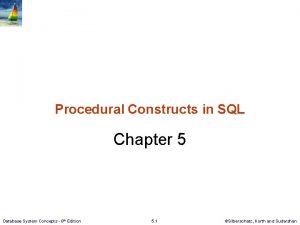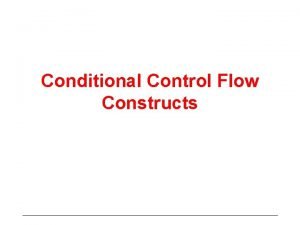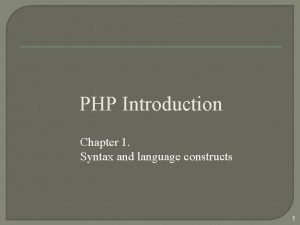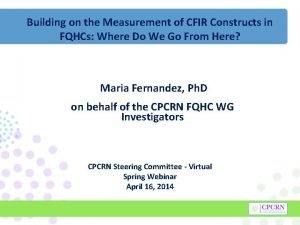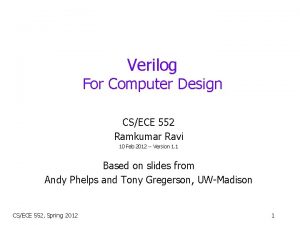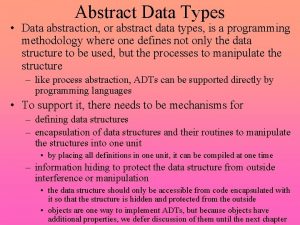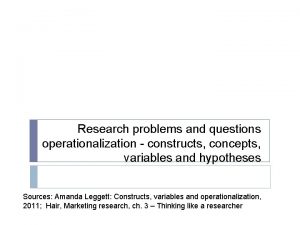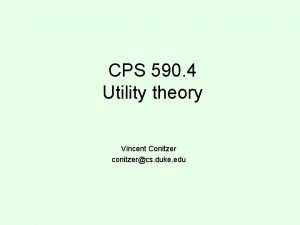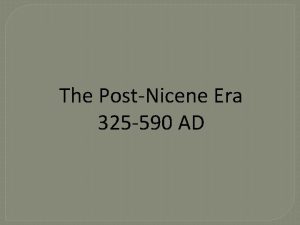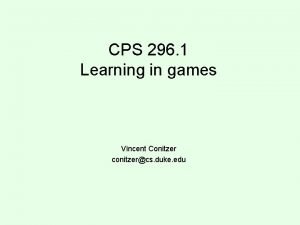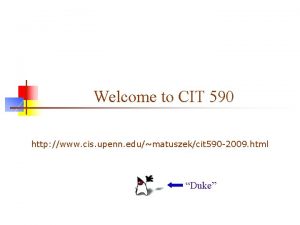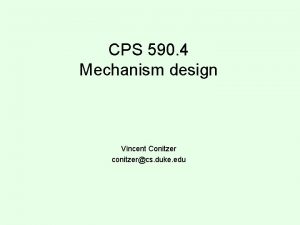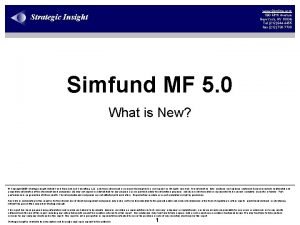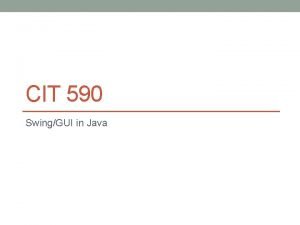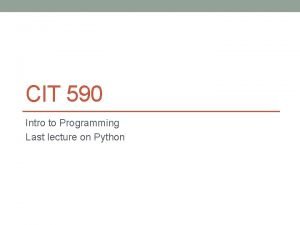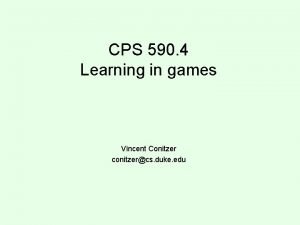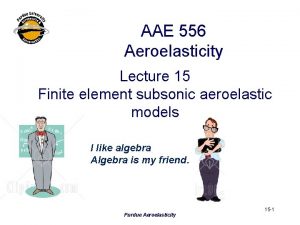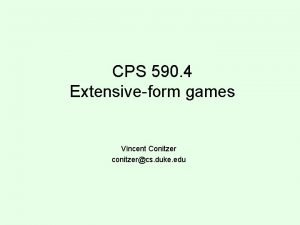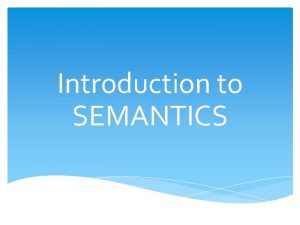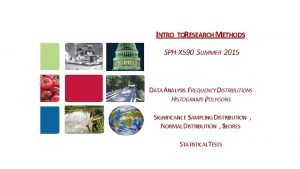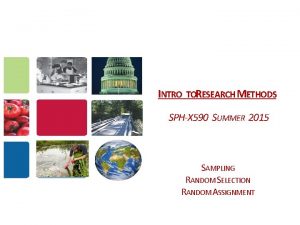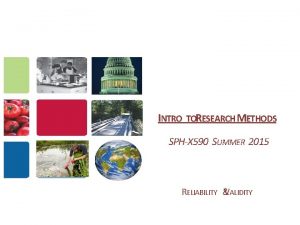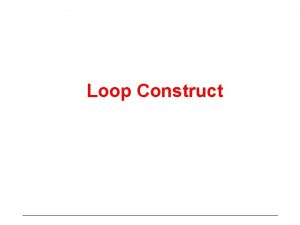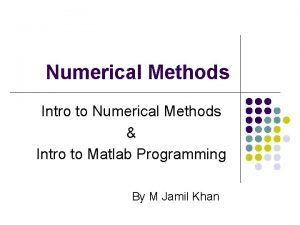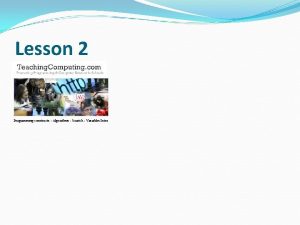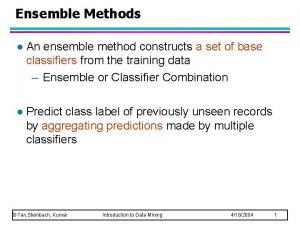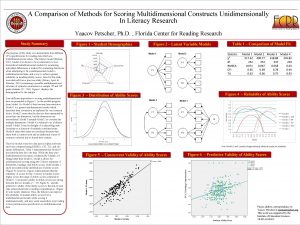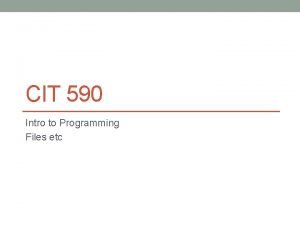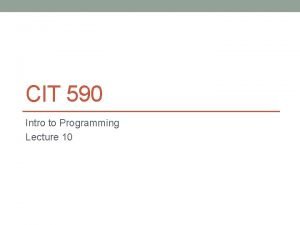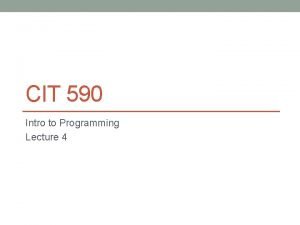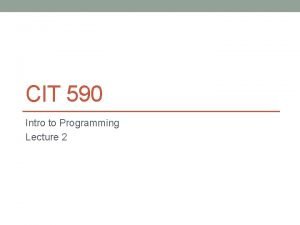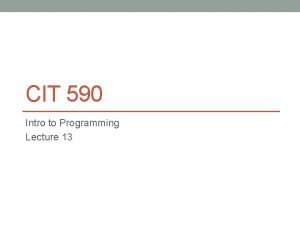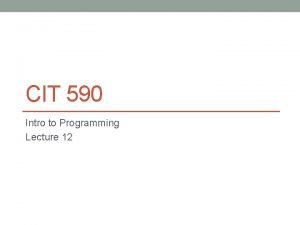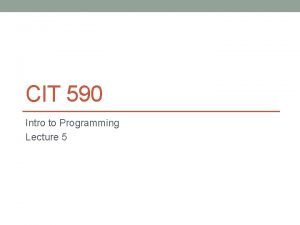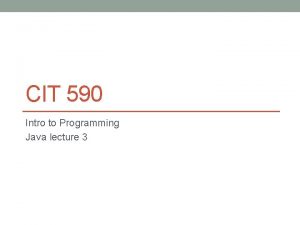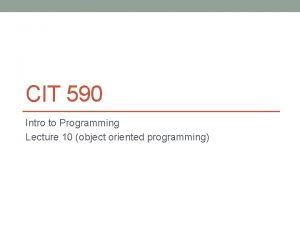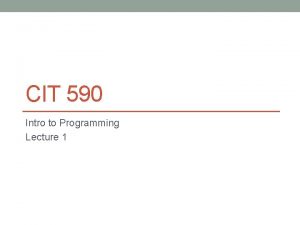INTRO TORESEARCH METHODS SPHX 590 SU 15 CONSTRUCTS































- Slides: 31

INTRO TORESEARCH METHODS SPH-X 590 SU 15 CONSTRUCTS C, ONCEPTS , & VARIABLES : DETAILS ANDD EFINITIONS

Presentation Outline From the beginning: • Empirical Research & Scientific Method: Dimensions, Directions, & Details • The Empirical Research Process: Problem Formulation to Dissemination • Disciplinary Differences: Social, Life & Natural Sciences From Review to New: • Refining Research Objectives/Questions – Originality and Innovation – Feasibility – Formal Strategies and Criteria

The Research Process: Disciplines & Differences • The Research Process of Scientific Method is the same in terms of its goals, logic, form and format across the Social, Life/ Health and Natural Sciences. • Terminology, Taxonomies, Conceptualization, & Methodological Focus o vary dramatically from discipline to discipline o major source of confusion • The history of scientific research as inner-disciplinary: research conducted within a discipline. o Scientific Research as its own discipline.

Empirical Research Process: Social, Life, & Natural Sciences • You have been introduced to conceptualization & measurement during the discussion of the philosophy of science and the nature of research. o Within the context of ontology, epistemology, & methodology • You were reintroduced to conceptualization & operationalization to illustrate the structure of research, the process of scientific investigation, and evaluation criteria of research o Problem Formulation, Literature Review, Research Objectives/ Questions o Hypothesis, and Study Design Components o Reproducibility = Reliability + Validity * Ethics • This presentation will be a “Re-reintroduction” , BUT in the context of Empirical Research. o Former discussions were broad to introduce general components, movement, and criteria; or, o Former discussions pointed out paradigmatic and philosophical differences. o General introduction to research as a discipline o Practical skills searching and reviewing the literature.

The Dimensions of Empirical Research: A movement from theoretical to analytical Theories Analysis Data Collection Hypotheses Deductive Reasoning EMPIRICAL RESEARCH SCIENTIFIC METHOD Variables Constructs Propositions Concepts Measurement Postulates

Empirical Research involves measures, participants & procedures An Empirical Research Methodology is explanation and the rationale of Constructs, Concepts, Variables, & Definitions and the Study Design these components indicate.

The Empirical Research Process: Step 1 Identification of Area of Study: Problem Formulation D E D U C T I O N T H E O R Y Step 2 Literature Review: Context Step 3 Research Objectives to Hypotheses: Content to Methodology • Concepts to Variables Step 4 Study Design I: Data Collection Methods • • Research Design: experimental, quasi-experimental, or non-experimental Time & Unit of Analysis Step 5 Procedures: Sampling, Assignment, Recruitment, & Ethics Step 6 Collection: Instruments, Materials, & Management Step 7 Study Design II: Analysis • • Statistical Approaches & Analytical Techniques Sample Size & Power Step 8 Results: Dissemination • Publication, Presentation, & New Application

Empirical Research: Level of Abstraction vs. Observation • Scientific Investigation operates at 2 levels: 1. Abstraction: Theoretical and Conceptual 2. Observation: Direct and Measurable

Empirical Research: Level of Abstraction vs. Observation • For example, consider this theoretical hypothesis/ postulate: o Early childhood deprivation increases latter learning difficulties. o 2 concepts related by the word: increases 1. early childhood deprivation 2. latter learning difficulties o These concepts are theoretical and/or conceptual: o Level of Abstraction

Empirical Research: Level of Abstraction vs. Observation • Empirical research operates at the Level of Observation. o In the previous example, the research must define the 2 concepts: early childhood deprivation, and latter learning difficulties; so that observations are possible. o Conceptualizing is the process of defining to the point of operationalizing. o Operationalizing is making the concept measurable: a variable with the operational definition Note: The words construct, concept and variables are often used interchangeably, but they are NOT synonymous.

Concepts • A concept is an abstraction formed from “generalizations” from “particular observations”. • For example, the concept of Academic Achievement is abstracted (i. e. generalized) from activities that children must learn in school. o Reading, writing, calculation, drawing pictures, etc. are the educational activities that children must learn/ master. o The concept, Academic Achievement, captures the variety of activities/behaviors and the mastery of these activities/ behaviors in a single phrase/word.

Constructs • A construct is a concept. o Typically the most abstracted level of a concept: a word o Constructs are deliberately and consciously created o Constructs may also have a specific scientific purpose or systematic use o The terms construct, concept, & variable are often used interchangeably, which is a huge source of confusion. o A measured concept is an operationalized variable. o A measured variable is a variable for which data has been collected. o A theoretical construct is a construct specified by a theory or used in a particular theoretical framework. o A scientific construct is a variable. o A constructed variable is a type of variable constructed from other variables ( kind of like a score). o Be aware of the generic use and specific use of the terms! o Always find out how the terms are being used!

Constructs • An example of a construct is Intelligence. • Intelligence is a concept generalized from / is an abstraction of observations of behaviors related to knowledge, skill, and aptitude. • Scientists consciously and deliberately created the construct of Intelligence and use it for specific/ systematic purpose. • As a scientific construct, Intelligence means is more than a concept. o o It is so defined and specified that it can be observed and measured. The IQ Test for example. • As a theoretical construct, Intelligence is less than a concept. o It is part of particular theoretical frameworks which relate it in various ways to other constructs.

Variables: Levels of Measurement As stated before, the terms construct, concept, and variable are often used synonymously to refer to the phenomenon or properties of the phenomenon they are studying. A variable is a symbol or representation to which we can assign numbers or values. The levels of measurement: nominal, ordinal, interval and ratio guide the numbers or values we assign. Be aware of other terms and/or groupings for the levels of measurement: • • o o • Remember during analysis, researchers often change a continuous into a categorical variable, change/collapse the number or categories, and/or combine/ construct variables: o o o Categorical and Continuous Discrete Ordinal, Continuous Ordinal and Continuous Quantitative vs. Quantitative Dichotomous vs. Polytomonous These details and rationale are essential to evaluating results. These details should be in the Methods section of an a research article or proposal. In practice categorizing a continuous variable into a dichotomous or polytonomous variable is convenient, maybe useful conceptually, but in terms of analysis, a lot of information is lost, so Beware!!

Variables: Levels of Measurement Generally, variables are either continuous or categorical. • A continuous variable is capable of taking on an ordered set of values within a certain range: negative infinity to positive infinity • A categorical variable specifies categories. o The categories are from nominal variable (e. g. Names of States) that were coded as numbers (Texas = 25, Alabama = 01). • A categorical variable has two or more subsets of the set of objects being measured. • Individuals, Places, Infects, Viruses, etc. categorized by their possession of the characteristic that defines any subset: a taxonomy o It’s all-or-nothing.

Variables: Levels of Measurement • The phrase “qualitative variable” is sometimes used to describe categorical variables. o Especially, dichotomous variables: variables with only 2 response: Yes/No o Often used in contrast to “quantitative variables” • The phrase “quantitative variables” is most often used to refer to continuous variables. o Theses uses are inaccurate, loose, and distorted. o Variables are always quantifiable, if they are not quantifiable, then not variables. o For example, the Variable X has only two subsets (i. e. 2 response categories) and each subset can only have 1 value (e. g. 0 or 1). o The values assigned to the subsets are quantitative and vary, so it is a variable. o FYI, variables with 0 or 1 for response values are “dummy variables”

Constitutive & Operational Definitions: Constructs, Concepts & Variables • Defining in terms of empirical research is the process of conceptualization and operationalization. o Going from construct to concept to variable • Two general ways to define: 1. Like a dictionary, defining a word by using other words • Constitutive Definition 2. Using expressed or implied behaviors to define • Behavioral or Observational Definition

Constitutive & Operational Definitions: Constructs, Concepts & Variables • A Constitutive Definition defines a construct/concepts using other constructs/concepts. • An Operational Definition assigns meaning to concept or to a variable by specifying the activities or “operations” necessary to measure it and evaluate the measurement. • In general, two kinds of Operational Definitions: 1. Measured 2. Experimental

Constitutive & Operational Definitions: Constructs, Concepts & Variables • A Measured Operational Definition describes how a variable will be measured. – For example, the self-reported, level of Trust on a 5 -point Likert Scale of agreement with statement • An Experimental Operational Definition is the details about how the variable is being manipulated/ how it operates. o For example, the concept of Reinforcement can be operationally defined as the rewards (vs. no rewards) Or punishments (vs. no punishments) for specified behaviors.

Constitutive & Operational Definitions: Constructs, Concepts & Variables • The Operational Definition is critical! o Enable researchers to measure variables o The bridge between the Abstract/Theoretical/ Conceptual Level and the Level of Observation. o No scientific research without observations o No observations without clear and specific details about what and how to observe. o The Operational Definition is are those details: the instructions. • Although operational definitions are critical to the scientific research process, variables are limited in capturing/ measuring theoretical constructs: a significant gap between theory and reality.

Operational Definitions: Specific to Broad • Definitions that refer to a test score are very specific. o For example, Intelligence is as a score on IQ intelligence test • A broader definitions require further specification to be measurable. o For example, Frustration defined as “prevention from reaching a goal” is more general • An example of a measured variable: Intrinsic Motivation defined operationally as, “The cumulative amount of time that each student played with the pattern blocks with the reward system absent. ”

Variables: Roles & Relationships Roles • • • Independent and Dependent Cause and Effect Exogenous and Endogenous Predictor and Outcome Exposure and Outcome Stimulus and Effect o All mean essentially the same thing! o Disciplinary Differences or Differences in Research Design Relationships • • No Relationship Positive Relationship Negative Relationship Curvilinear Relationship

Variables: Roles & Relationships • An independent variable is the supposed cause of the dependent variable, the supposed effect. • As general rule, the independent variable is: o the variable that the researcher manipulates; or, o the characteristic that researcher uses to assign participants to groups • The logic: If A, then B o An independent variable (A) is the condition of a dependent variable (B): a conditional conjunction

Variables: Roles & Research Designs • In experimental research designs, the independent variable is actively manipulated. o The researcher randomly assigns subjects to a condition: for example, control or treatment group. • • In quasi-experimental designs, the independent variable can be a fixed characteristic of a person, for example, or a random effect like a person’s voting. In quasi-experimental designs, natural experiments may exist. o In this situation, the independent variable is “pre-manipulated”: pre-existing/ natural control and experimental groups; or comparison groups o For some for logistical, legal/ethical, practical reason, an independent variable that could be manipulated in an experiment, was not. • For example, comparing different the effect of private vs. public school education on cognitive and functional measures of students. o The independent variable is the type of school (private vs. public) o The researchers have to study the subjects (i. e. the students) after they had been “assigned” to a school.

Variables: Indefinite & Definite • • • Active and Attribute Variables Manipulated and Measured Variables Manipulated and Subject-Characteristic Variables Achieved and Ascribed Variables State and Trait Variables Varying and Non-Varying Variables Time Varying and Time In-varying Variables Random and Fixed Variables Random and Non-Random Variables Latent and Manifest Variables Latent and Observed Variables Indirect and Direct Variables Generally, BUT NOT ALWAYS, mean the same thing and refer to things about, for example, a person that can and cannot be changed/ manipulated by the researcher. • • • A person’s eye color is fixed, non-random, ascribed, attribute, etc. A person’s voting behavior is random, active, state, varying, etc. Subject’s are randomly assigned by the researcher to a control or experimental condition

Variables: Indefinite & Definite • The variables can be or are manipulated by the researcher are active, states, varying, random etc. – The variable that captures the different things being done to different groups of subjects/participants: for example, the stimulus or the experimental group. • Variables that are fixed and cannot be manipulated are attributes or characteristic of the subjects/ participants. o Subjects come to a study with these variables (attributes) ready-made or preexisting: for example, having blue eyes

Operational Definitions: For Experiments • An experimental variable: o For example, a researcher gives subjects bogus results on a Self-Esteem test. o The researcher divides the subjects with the same measured level (i. e. Test score) of Self-Esteem into three feedback groups: 1. positive, 2. negative, and 3. none. o In the positive feedback condition (i. e. positive self-esteem), the researcher describes subjects with statements such as “clear thinking. ” o Those subjects in the negative group (i. e. negative selfesteem) are given adjectives like “passive in action. ” o The researchers does not give feedback to subjects in the “no feedback” group. o They are told that their personality profiles (i. e. Self-Esteem test score) were not ready due to a backlog.

Variables: Indefinite & Definite • Terms like attributes, characteristic, behavior, fixed effect can be confusing for many reasons: generic and specific uses; disciplinary differences; research design choice, etc. • Some variables that you might think are attributes of a person can active, random, a state. o For example, measuring vs. manipulating a participant's Anxiety o Anxiety is a trait (fixed) of a person if measured at one point: treated like a pre-existing condition, treated like eye-color. o Anxiety can also be a state (random) if manipulated during the research by inducing different degrees of stress • Do not assume the same operational definition for measured and the manipulated variables. – In this example, Anxiety is only similar in a broad/ abstracted sense, but is very different in terms of operational definitions.

Constructs: Observed & Latent Variables • Constructs are unobservable. o variables, when operationally defined, are observable. • A Latent Variable is something unobserved, but is presumed to underlie observed or manifest variables. o Intelligence is an important Latent Variable. o Verbal, Numerical, and Spatial abilities are concepts of Intelligence. o The observed scores on the three ability tests used to measure these concepts are positively and substantially related. o Because three concepts are related to the same underlying construct, the observed variables (i. e. the observed scores on the three ability tests) can measure the construct of Intelligence. o The underlying construct is Intelligence: It is a Latent Variable.

Constructs: Observed & Latent Variables • When we articulate a theory, we articulating in part systematic relations among latent variables (i. e. constructs). o For example, observed behaviors of Frustration and the observed behaviors of Aggression are not interesting substantively, even though they are important at the empirical level. o What is really interesting is the relationship between the latent variable/construct of Frustration and the latent variable/construct of Aggression.

Constructs: Observed & Latent Variables • Motivation is a latent variable. • Social-Psychologists invented this construct within the Socio-Cognitive theoretical framework of behavior. o This means that researchers must always measure presumed indicators of Motivation, but cannot measure Motivation itself.
 Procedural constructs
Procedural constructs Control flow constructs
Control flow constructs Php language constructs
Php language constructs Cfir
Cfir Non synthesizable constructs in verilog
Non synthesizable constructs in verilog The calvin cycle constructs
The calvin cycle constructs Abstract data type
Abstract data type Conceptualization and operationalization in research
Conceptualization and operationalization in research Sending and receiving signals are special constructs of
Sending and receiving signals are special constructs of Schema assicurazione patente
Schema assicurazione patente Blue letter bible app
Blue letter bible app Cps590
Cps590 590 ad
590 ad Cps 590
Cps 590 To where did constantine move rome's capital
To where did constantine move rome's capital Cit penn
Cit penn Cps590
Cps590 590 fifth avenue
590 fifth avenue Java 590
Java 590 Cit 590
Cit 590 105 cmr 590
105 cmr 590 Toefl itp 590
Toefl itp 590 Cps 590
Cps 590 Ahri 550/590
Ahri 550/590 Aeroelasticity
Aeroelasticity Cps 590
Cps 590 The medieval church (590-1517 ce)
The medieval church (590-1517 ce) Cps 590
Cps 590 Inlay wax pattern fabrication
Inlay wax pattern fabrication Romeo and juliet act 1 prologue modern english
Romeo and juliet act 1 prologue modern english Intro to hadoop
Intro to hadoop Intro to semantics
Intro to semantics
